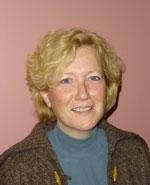Paula Donovan
Paula Donovan is an American women's rights activist that strongly promotes infant male circumcision.[1]
| Paula Donovan |
| Former employment: |
| UNICEF |
| Current employment: |
| AIDS Free World |
| Benefactor: |
| Stephen H. Lewis |
| Self described: |
| Womens Activist / Feminist |
| Promotes: |
| Routine Infant Circumcision |
Donovan previously served as a Senior Advisor in the office of the United Nations Secretary General's Special Envoy for AIDS in Africa and is a 20-year veteran of international development, women's rights and HIV/AIDS.[2] In the early '90s, she worked at UNICEF and ran the global advocacy campaign for breastfeeding. Later, she became chief aide to UNICEF's deputy executive director, and spent four years in Kenya as East and Southern Africa's Regional AIDS advisor for UNICEF.[3]
Contents
Quote
| “ | Stephen Lewis: on Paula Donovan She [Paula Donovan] realized that male circumcision was a good preventative way to slow the spread of AIDS. So she took that analysis further. She suggested to the male leadership in Nairobi, that UNICEF propose that circumcision accompany the regular process of immunization of infants... Paula was easily 10 years ahead of her time, because that's exactly what's being discussed in several countries now... and what did the UNICEF hierarchy do at the time? They grabbed their genitals in protective embrace and laughed it off like only male sexists can laugh things off. ...the UN took more than a decade to see male circumcision for the inspired preventative technology that it is. – Lewis, S. (Youtube)[1] |
UN General Assembly
Her efforts resulted in the UN General Assembly passing a resolution which supported a new consolidated body – to be headed by an under-secretary-general – to deal with issues concerning women.[4] The resolution merged the UN Development Fund for Women (UNIFEM), the Division for the Advancement of Women, the Office of the Special Adviser on Gender Issues and the UN International Research and Training Institute for the Advancement of Women (UN-INSTRAW).[5]
AIDS Free World
AIDS-Free World is an international advocacy organization with a small staff that works virtually from a dozen locations in the US and Canada, Africa, the Caribbean and Europe.[6] Co-Directors Paula Donovan and Stephen H. Lewis founded AIDS-Free World in 2007.[6][1]
Population-based studies
September 2021 saw the publication of two huge population studies on the relationship of circumcision and HIV infection:
- Mayan et al. (2021) carried out a massive empirical study of the male population of the province of Ontario, Canada (569,950 males), of whom 203,588 (35.7%) were circumcised between 1991 and 2017. The study concluded that circumcision status is not related to risk of HIV infection.[7]
- Morten Frisch & Jacob Simonsen (2021) carried out a large scale empirical population study in Denmark of 855,654 males regarding the alleged value of male circumcision in preventing HIV and other sexually transmitted infections in men. They found that circumcised men have a higher rate of STI and HIV infection overall than intact men.[8]
No association between lack of circumcision and risk of HIV infection was found by either study. There now is credible evidence that the massive, expensive African circumcision programs have not been effective in preventing HIV infection.
Two African surveys
The previously reported studies were from developed Western nations. Now we have information from Sub_Saharan Africa.
French scientist Michel Garenne, Ph.D. has published two reports in 2022 comparing the incidence of HIV infection in circumcised and intact men.
In his first report, Garenne presented the findings from a study in Lesotho, the enclave in South Africa. He reported:
In couple studies, the effect of circumcision and VMMC on HIV was not significant, with similar transmission from female to male and male to female. The study questions the amount of effort and money spent on VMMC in Lesotho.[9]
In his second report, Garenne (2022) presented information from six Sub-Saharan African nations (Eswatini, Lesotho, Malawi, Namibia, Zambia, Zimbabwe). He reported:
"Results matched earlier observations made in South Africa that circumcised and intact men had similar levels of HIV infection."[10]
See also
- UNICEF -- Donovan worked here.
- Stephen H. Lewis -- Benefactor of Donovan. Headed UNAIDS, promotes infant circumcision.
- United States of America
External links
- The Circumfetish Magazine Awards - World AIDS Day Special -- Paula Donovan hosts the awards (satire)
References
- ↑ a b c Lewis, Stephen (6 January 2010).
YouTube: AIDSFreeWorld: Male Circumcision, part 1
[YouTube: AIDSFreeWorld: Männliche Beschneidung, Teil 1] (Englisch). Retrieved 28 October 2011. - ↑ The Salem Award: Paula Donovan
- ↑ Fairfield University: Paula Donovan
- ↑ Behind the U.N. hoopla, a new agency for women emerges
- ↑ UN to Establish Single New Agency to Deal with Rights of Women
- ↑ a b AIDS Free World.
Who We Are - AIDS Free World
. Retrieved 28 October 2011. - ↑ Mayan M, Hamilton RJ, Juurlink DN, Austin PC, Jarvi KA. Circumcision and Risk of HIV Among Males From Ontario, Canada. J Urol. 23 September 2021; PMID. DOI. Retrieved 21 August 2022.
Quote:We found that circumcision was not independently associated with the risk of acquiring HIV among men from Ontario, Canada.
- ↑ Frisch M, Simonsen J. Non-therapeutic male circumcision in infancy or childhood and risk of human immunodeficiency virus and other sexually transmitted infections: national cohort study in Denmark. Eur J Epidemiol. 26 September 2021; 37: 251–9. PMID. DOI. Retrieved 16 January 2022.
- ↑ Garenne M. Changing relationships between HIV prevalence and circumcision in Lesotho. J Biosoc Sci. 4 April 2022; online ahead of print: 1-16. PMID. DOI. Retrieved 28 October 2022.
- ↑ Garenne M. Age-incidence and prevalence of HIV among intact and circumcised men: an analysis of PHIA surveys in Southern Africa. J Biosoc Sci. 26 October 2022; : 1-13. PMID. DOI. Retrieved 27 October 2022.
